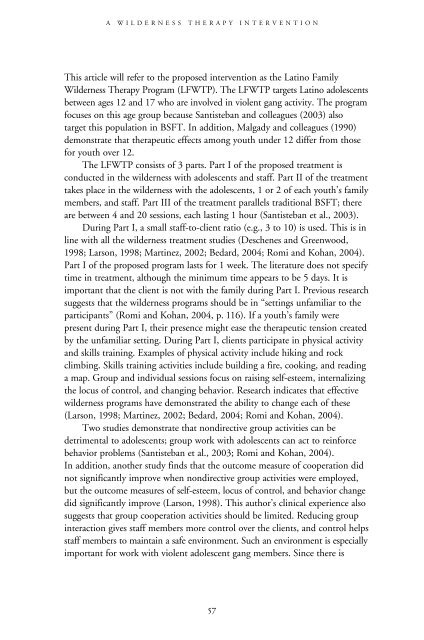2006 - School of Social Service Administration - University of Chicago
2006 - School of Social Service Administration - University of Chicago
2006 - School of Social Service Administration - University of Chicago
You also want an ePaper? Increase the reach of your titles
YUMPU automatically turns print PDFs into web optimized ePapers that Google loves.
A WILDERNESS THERAPY INTERVENTION<br />
This article will refer to the proposed intervention as the Latino Family<br />
Wilderness Therapy Program (LFWTP). The LFWTP targets Latino adolescents<br />
between ages 12 and 17 who are involved in violent gang activity. The program<br />
focuses on this age group because Santisteban and colleagues (2003) also<br />
target this population in BSFT. In addition, Malgady and colleagues (1990)<br />
demonstrate that therapeutic effects among youth under 12 differ from those<br />
for youth over 12.<br />
The LFWTP consists <strong>of</strong> 3 parts. Part I <strong>of</strong> the proposed treatment is<br />
conducted in the wilderness with adolescents and staff. Part II <strong>of</strong> the treatment<br />
takes place in the wilderness with the adolescents, 1 or 2 <strong>of</strong> each youth’s family<br />
members, and staff. Part III <strong>of</strong> the treatment parallels traditional BSFT; there<br />
are between 4 and 20 sessions, each lasting 1 hour (Santisteban et al., 2003).<br />
During Part I, a small staff-to-client ratio (e.g., 3 to 10) is used. This is in<br />
line with all the wilderness treatment studies (Deschenes and Greenwood,<br />
1998; Larson, 1998; Martinez, 2002; Bedard, 2004; Romi and Kohan, 2004).<br />
Part I <strong>of</strong> the proposed program lasts for 1 week. The literature does not specify<br />
time in treatment, although the minimum time appears to be 5 days. It is<br />
important that the client is not with the family during Part I. Previous research<br />
suggests that the wilderness programs should be in “settings unfamiliar to the<br />
participants” (Romi and Kohan, 2004, p. 116). If a youth’s family were<br />
present during Part I, their presence might ease the therapeutic tension created<br />
by the unfamiliar setting. During Part I, clients participate in physical activity<br />
and skills training. Examples <strong>of</strong> physical activity include hiking and rock<br />
climbing. Skills training activities include building a fire, cooking, and reading<br />
a map. Group and individual sessions focus on raising self-esteem, internalizing<br />
the locus <strong>of</strong> control, and changing behavior. Research indicates that effective<br />
wilderness programs have demonstrated the ability to change each <strong>of</strong> these<br />
(Larson, 1998; Martinez, 2002; Bedard, 2004; Romi and Kohan, 2004).<br />
Two studies demonstrate that nondirective group activities can be<br />
detrimental to adolescents; group work with adolescents can act to reinforce<br />
behavior problems (Santisteban et al., 2003; Romi and Kohan, 2004).<br />
In addition, another study finds that the outcome measure <strong>of</strong> cooperation did<br />
not significantly improve when nondirective group activities were employed,<br />
but the outcome measures <strong>of</strong> self-esteem, locus <strong>of</strong> control, and behavior change<br />
did significantly improve (Larson, 1998). This author’s clinical experience also<br />
suggests that group cooperation activities should be limited. Reducing group<br />
interaction gives staff members more control over the clients, and control helps<br />
staff members to maintain a safe environment. Such an environment is especially<br />
important for work with violent adolescent gang members. Since there is<br />
57
















